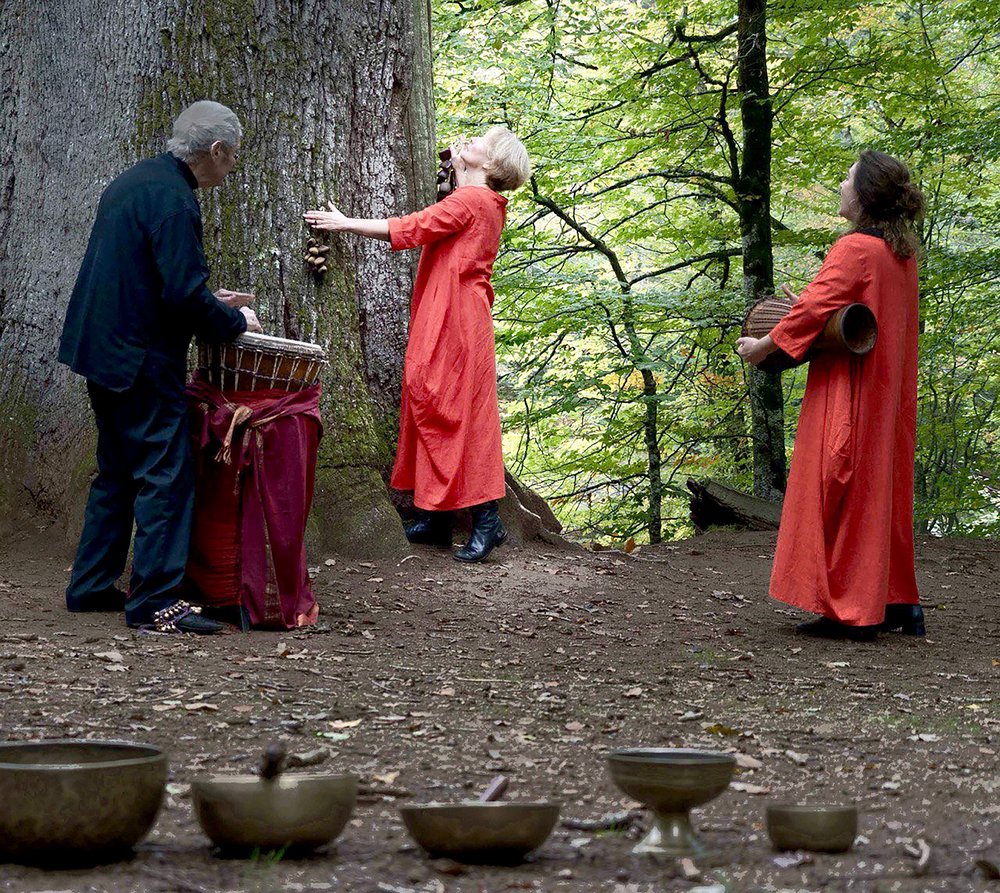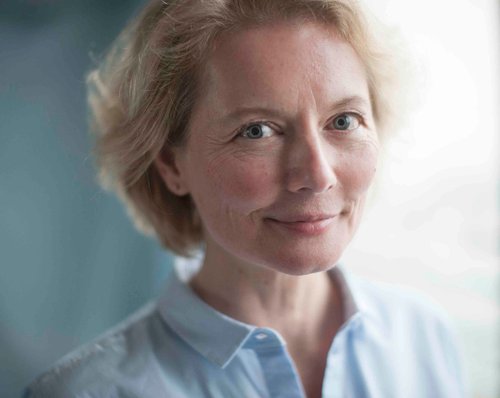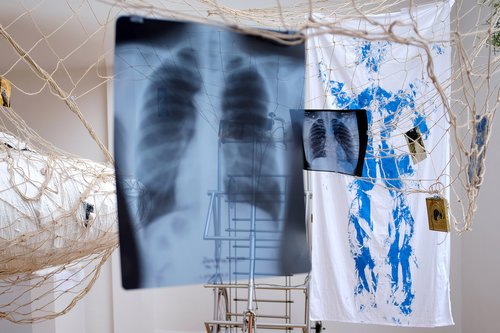Between Memory and Resilience, Kisseleva and the Intelligence of Nature

Olga Kisseleva. Oaks That Think They Are Baobabs. Photo by Michel Masson. Courtesy of the artist
Olga Kisseleva explores the intelligence and resilience of trees which are enduring unprecedented levels of environmental stress. Her current solo exhibition in France, at the contemporary art centre Le Bel Ordinaire in Billere, “Oaks That Think They Are Baobabs” investigates the adaptive responses of trees to climate change as well as our own potential as human beings to learn from nature.
“The oak trees are under stress – they are imagining themselves as baobabs”, is how a scientist from Pau recently described the current state of oak trees in the historic region of Béarn south-west France in a conversation with multimedia artist Olga Kisseleva (b. 1965), an artist and researcher at the Panthéon Sorbonne University in France who has been studying tree behaviour and communication for years. In Béarn, dense forests begin on the slopes of the Pyrenees and gently descend to the foothills. The town of Pau has long been famous for its oak groves, in the 17th century a favourite hunting ground of Henri IV. Centuries have passed since then and the forests have been replaced by farmland, oak trees remaining, however, a symbol of Pau. Yet today, with climate change, frequent storms and abnormal temperatures, trees that are not used to 20 degrees celsius of heat in November start to “panic” as the scientist puts it. They gather water, the shape of the crown changes, leaves are shed – in other words they have started to behave like their fellow baobabs that live in a more extreme climate. This is the starting point for Kisseleva's solo exhibition “Oaks That Think They are Baobabs”, which focuses on natural intelligence and the possibilities of communicating with trees.
In her scientific and artistic research at the intersection of ecology, sociology, philosophy and art, Olga Kisseleva searches for answers about the past, present and future, taking knowledge from nature as its basis. For many years Kisseleva has been observing trees all over the world from the Amazonian forests and ancient oak groves of France to thousand-year-old olive groves in Greece and the unique flora of the Indian Oceanic islands. Her personal quest has resulted in works of art that address critical issues relating to ecology, biopolitics, urbanism, cultural memory and future technologies, and seeks to restore and strengthen our human connection with nature. These works are expressed in a wide variety of different genres and media, from installations, paintings, video projections and data visualisations to performances, choreographic productions and organic sculptures. Trees, Kisseleva believes, can tell us a lot of stories.
In their global art practices, contemporary artists are increasingly turning to the primal elements of nature and the foundations of the universe in search of sustainable models of coexistence. This approach to environmental and ecological art brings Kisseleva closer to a number of artists whose practices grow out of scientific projects exploring individual bio-organisms and elements drawn from nature.
There is the work of world renown Argentine artist Tomas Saraceno (b. 1973), who set out to understand more about ecosystem harmony from spiders. He sees cobwebs as a metaphor for interconnectedness and symbiotic relationships. British environmental artist Chris Drury (b. 1948), who has studied mushrooms and their spore prints for decades, calls them "nature's great recyclers" for their ability to return organic matter to the ecosystem. For Drury, mushrooms, which decompose dead matter and turn it into soil, have come to symbolise the cycle of life, death and regeneration. German artist Theresa Schubert (b. 1980) creates techno-organic biopoetic installations, combining algorithms and artificial intelligence with living organisms such as bacteria, algae, fungi, plants. For Olga Kisseleva they are trees, for Tomas Saraceno, spiders, for Chris Drury they are mushrooms, and for Theresa Schubert they are living organisms, all are full-fledged ‘co-authors’ of their works. The artists emphasise the importance of their co-creators as beings with unique memory and intelligence, thus making an important contribution to the understanding of symbiotic relationships and the interconnectedness of all forms of life.
At the same time, the choice of a specific object for scientific and artistic research does not limit the artists of environmental and ecological art in posing questions of interest to them. The artists believe that nature can provide answers to many important topics: our human impact on the environment, problems of the Anthropocene, our local cultures in the context of attitudes towards nature, climate change, sustainable consumption, restoration and regeneration of ecosystems, the study of hidden processes that shape ecosystems, questions of identity and psychology. A long and inexhausitible list.
For Olga Kisseleva, the most emotionally challenging part of her global art practice are the themes of memory and collective trauma. Working with trees which are growing on the sites of past tragedies, she questions how natural materials and ecosystems can serve as “inhuman witnesses” to mass violence and war crimes. Auschwitz, Gurs (a town in the Pyrenees where a Nazi concentration camp was established under the Vichy regime), and Babi Yar Kisseleva applies dendrochronology as well as analysing data from various sensors. The black rings on the section of a 90-year-old tree from Gürs (‘Dans le corps de l’arbre’, 2024) become a mute testimony to human tragedies deeply embedded in the fabric of nature.
Nature acts as a witness to historical events and a repository of trauma similarly in the work of Susan Schuppli (b. 1959), an artist-researcher, professor and director of the Centre for the Study of Architecture at Goldsmiths University, London. Schuppli studies historical events involving political violence, ethnic conflict and war crimes, and in recent years has sought out such evidence in polluted bodies of water, perpetual snow and glaciers. By thus recording traces of human intervention, both Kisseleva and Schuppli offer a new perspective on ecological degradation.
Another important aspect which is presented in the exhibition and reflected in Olga Kisseleva's artistic practice is the concept of ancestral futurism, which combines ancestral traditions with a vision of the future. The philosophy of ancestral futurism is closely connected with questions of cultural identity, as well as with the traditions, customs and mythology of indigenous peoples. There are artists such as Skawennati (b. 1969), a multimedia artist of Mohawk descent living in Montreal; French-Guiana-Danish artist Tabita Rezaire (b. 1989), who works at the intersection of digital media, Afrofuturism and ritualistic practices; or Cuban-American artist Maria Magdalena Campos-Pons (b. 1959), who explores contemporary indigenous culture through the lens of ancestrofuturism, all of whom reflect deeply on what their lives might look like in the future.
Ancestrofuturism combines traditional knowledge accumulated by various species and living systems with modern scientific methods and progressive social ideas, creating a synthesis of past and future to find sustainable patterns of life. Olga Kisseleva believes that the study of ancient ecosystems can help to develop functioning models of the future, applicable to numerous sciences ranging from botany and breeding to urbanism, architecture and urban planning.


















